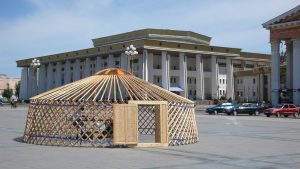May 16 was the deadline for candidates in the June 24 parliamentary election in Mongolia to be nominated. Suddenly, many new candidates are running in the 2020 election — as independents, with new parties, and with the established parties.
Over the past decade, voter frustration with established parties has been building up. While these established parties will likely take most of the 76 seats in the State Great Khural, the decision by many independent thinkers to stand for election suggests that belief in democracy remains strong and that a reinvigoration of public participation in setting Mongolia’s course may be possible.
In the 2016 parliamentary and 2017 presidential elections it became apparent that Mongolian voters had developed doubts about some of their political institutions, especially political parties, and perhaps were even questioning democracy. For example, over 8 percent of voters submitted a blank ballot in the second round of the 2017 presidential election, actively voicing their displeasure with the two candidates. In recent years, Mongolia has also been roiled by a series of corruption scandals that have further tainted politicians’ reputation. This has led to fears about democratic backsliding.
Amid a fairly successful response to the COVID-19 pandemic, Mongolia is holding its parliamentary election on June 24 on its usual four-year cycle. Equally cyclical is yet another revision of the electoral system, this time reverting to the 2008 system of multi-member majoritarian voting. Mongolia has been divided into 29 electoral districts (provinces and capital city districts) which will each elect two to three MPs. This electoral system is rarely used in national elections elsewhere; it is known to be unfavorable to women candidates but may benefit prominent candidates, whether they are new or long-established.
A total of 670 candidates are running in the election; 208 are independents. Two parties and one electoral coalition are running full slates of candidates. The Ulaanbaatar district of Sukhbaatar has the greatest number of candidates (28) competing for three seats, while western Uvs, with its 20 candidates, has the greatest number outside the capital.
When considering whether this election might bring an important shift in Mongolia’s political culture, there are three different kinds of new candidates in this election: new candidates with the established parties — Mongolian People’s Party (MPP), Democratic Party (DP) and Mongolian People’s Revolutionary Party (MPRP) — candidates in new(ish) parties (especially the National Labor Party), and independents.
Some of the fiercest battles will be fought in urban electoral districts. In Ulaanbaatar’s Sukhbaatar district the three candidates running for the governing MPP include the current and previous foreign ministers, D. Tsogtbaatar and Ts. Munkh-Orgil, respectively, but they are pitted against former DP Prime Minister R. Amarjargal; prominent economist and a leading figure of the upstart National Labor Party, B. Munkhsoyol; and leader of the neo-nationalist movement “Bosoo Huh Mongol,” P. Shinjeeravdan, in a battle for three parliamentary seats among 28 candidates in that district.
By contrast, there are many rural provinces where the established party candidates seem stacked to make it highly unlikely for any new candidates to win a seat. Eastern Mongolian Khentii, for example, boasts current Prime Minister U. Khurelsukh, current Cabinet Secretary L. Oyun-Erdene, and former presidential candidate and champion wrestler B. Bat-Erdene as candidates for the MPP.
Perhaps the trend of more and more relevant newcomers in the city is an acknowledgment of the long-time political dominance of the capital, which the distribution of seats in the country has not quite caught up with.
Women could potentially contribute to a change in political culture. Political parties and coalitions are required by the Election Law to have women make up a quota of at least 20 percent of candidates. Currently, among the two major parties, the MPP has 16 and the DP has 17 female candidates, just over the 20 percent quota. One of the major electoral coalitions is the Right Person Electorate Coalition, with 16 women out of their 59 candidates (27 percent).
The atmosphere around this year’s election is different from previous contests because of the diverse set of candidates; it ranges from politicians who have dominated politics for the past 30 years to the ones who have made names for themselves on (social) media as well as the leaders of neo-nationalist movements and human rights activists. The active use of social media presents an opportunity for level playing fields for candidates to engage with voters. Many voters express the view that they have been through seven cycles of broken (reform) promises in the past, so some may be leaning toward the new voices that are presenting themselves in this election.
Many of the new candidates who have cast their political frustrations aside and embraced the possibility of being elected in what remains a free contest may not win. But there is some chance at least that their campaigns will showcase the possibility of a different relationship between the electorate, candidates, and parties. This would signal a real shift in Mongolia’s political culture that could nudge political discourse in the direction of concrete policy debates that have been lacking in previous elections. This signal may be particularly important to young voters, whose understanding of democracy is still evolving.
Bulgan Batdorj is starting the Ph.D. program in Resources, Environment and Sustainability at the University of British Columbia in the fall of 2020. Julian Dierkes teaches in UBC’s Master of Public Policy and Global Affairs.

































